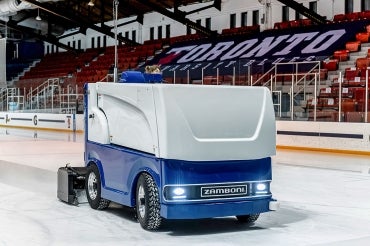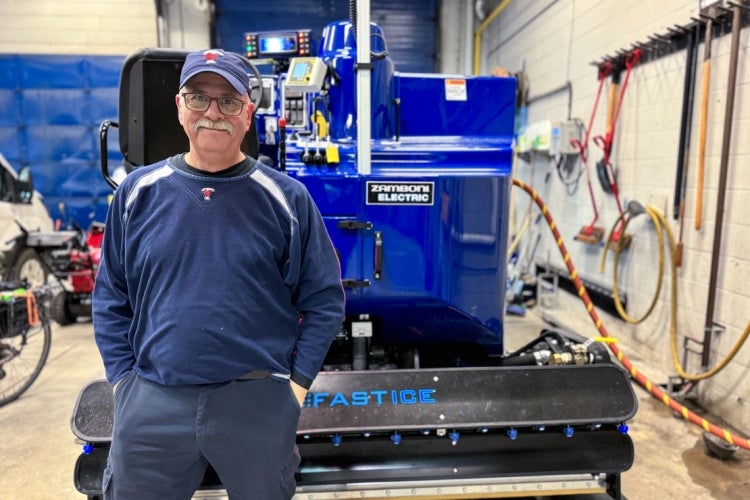Cleaner air, better ice: U of T acquires electric Zamboni for Varsity Arena

U of T’s Varsity Arena joins an estimated quarter of the roughly 1,000 indoor rinks in Ontario that are now serviced by electric ice resurfacers (photo by Seyran Mammadov)
Published: February 16, 2024
The University of Toronto’s Faculty of Kinesiology & Physical Education (KPE) has acquired an electric ice resurfacing machine for the Varsity Arena, a zero-emissions vehicle that will improve the quality of ice – and air.
Often referred to as “Zambonis” after Frank J. Zamboni, Jr., a block ice salesman who patented the technology in 1953, ice resurfacing machines maintain the skating surface by shaving the top layer of ice, washing the remaining ice and then spreading out an even layer of water that freezes between skate times.
But a growing number of rinks are now moving away from gas-powered Zambonis since they emit exhaust fumes that pollute indoor air.
“An electric Zamboni eliminates the source of indoor air pollution and reduces the ventilation requirements for the arena, which means energy savings and operational cost reductions for the facility,” says Ian Stephen, assistant facility manager at the Varsity Arena and Goldring Centre for High Performance Sport.
“It also provides a superior system of maintaining ice in the arena.”
U of T’s Varsity Arena joins an estimated quarter of the roughly 1,000 indoor rinks in Ontario now serviced by electric ice resurfacers following Health Canada’s 2021 recommendations to use electric resurfacers and edgers to improve air quality in arenas.

The electric Zamboni also makes better ice by using laser beams, a technology first used in the construction industry to level ground. To set it up, the Varsity Arena rink pad had to be measured first without ice to factor in any high or low spots.
“With the laser mounted on a pole and the receiver on the Zamboni, the blade moves automatically to create the most level ice possible,” Stephen says.
Another new feature is so-called “fast ice,” which is created with misting jets on the back of the electric Zamboni.
“They mist water onto the ice as opposed to it dripping down and a flutter cloth just dragging the water and trying to fill in everything,” says Stephen. “The misting helps take some of the oxygen out of the water, which makes the ice harder when it freezes – so it also creates a better surface.”
While electric Zambonis are more expensive than the gas-powered models, they are expected to save on fuel and maintenance over their lifetimes.
“Think of all the savings on energy, water and time,” Stephens says.
In addition to the electric Zamboni, KPE has also replaced a pick-up truck that hauled equipment with an electric van – one of several environmentally conscious projects underway at the university.



